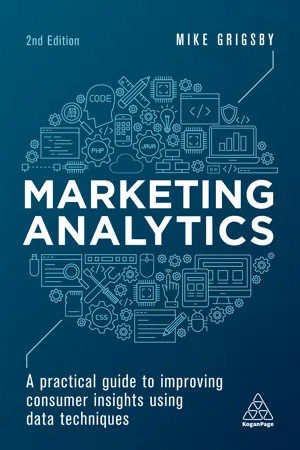
Marketing Analytics
A Practical Guide to Improving Consumer Insights Using Data Techniques
- English
- ePUB (mobile friendly)
- Available on iOS & Android
Marketing Analytics
A Practical Guide to Improving Consumer Insights Using Data Techniques
About this book
Who is most likely to buy and what is the best way to target them? How can businesses improve strategy without identifying the key influencing factors? The second edition of Marketing Analytics enables marketers and business analysts to leverage predictive techniques to measure and improve marketing performance. By exploring real-world marketing challenges, it provides clear, jargon-free explanations on how to apply different analytical models for each purpose. From targeted list creation and data segmentation, to testing campaign effectiveness, pricing structures and forecasting demand, this book offers a welcome handbook on how statistics, consumer analytics and modelling can be put to optimal use. The fully revised second edition of Marketing Analytics includes three new chapters on big data analytics, insights and panel regression, including how to collect, separate and analyze big data. All of the advanced tools and techniques for predictive analytics have been updated, translating models such as tobit analysis for customer lifetime value into everyday use. Whether an experienced practitioner or having no prior knowledge, methodologies are simplified to ensure the more complex aspects of data and analytics are fully accessible for any level of application. Complete with downloadable data sets and test bank resources, this book supplies a concrete foundation to optimize marketing analytics for day-to-day business advantage.
Frequently asked questions
- Essential is ideal for learners and professionals who enjoy exploring a wide range of subjects. Access the Essential Library with 800,000+ trusted titles and best-sellers across business, personal growth, and the humanities. Includes unlimited reading time and Standard Read Aloud voice.
- Complete: Perfect for advanced learners and researchers needing full, unrestricted access. Unlock 1.4M+ books across hundreds of subjects, including academic and specialized titles. The Complete Plan also includes advanced features like Premium Read Aloud and Research Assistant.
Please note we cannot support devices running on iOS 13 and Android 7 or earlier. Learn more about using the app.
Information
PART ONE
Overview
01
A brief statistics review
Measures of central tendency
Measures of dispersion

| X | X-mean | Squared | |
2 | –23 | 529.3 | |
5 | –20 | 400.3 | |
8 | –17 | 289.2 | |
10.9 | –14.1 | 199.3 | |
13.9 | –11.1 | 123.6 | |
16.9 | –8.1 | 65.9 | |
19.9 | –5.1 | 26.2 | |
22.9 | –2.1 | 4.5 | |
25.9 | 0.9 | 0.8 | |
28.9 | 3.9 | 15.1 | |
31.9 | 6.9 | 47.4 | |
33 | 8 | 63.9 | |
34 | 9 | 80.9 | |
35 | 10 | 99.9 | |
36 | 11 | 120.9 | |
39 | 14 | 195.8 | |
42 | 17 | 288.8 | |
45 | 20 | 399.7 | |
Mean = 25.0 | Sum = 2,951.5 | ||
Count = 18 | Variance = 173.6 |
Table of contents
- Cover
- Title Page
- Copyright
- Contents
- List of Figures
- Foreword to the first edition
- Foreword to the second edition
- Preface
- Introduction to marketing analytics
- PART ONE Overview – how can marketing analytics help you?
- PART TWO Dependent variable techniques
- PART THREE Inter-relationship techniques
- PART FOUR More important topics for everyday marketing
- PART FIVE Conclusion
- Glossary
- Bibliography and further reading
- Index
- Backcover